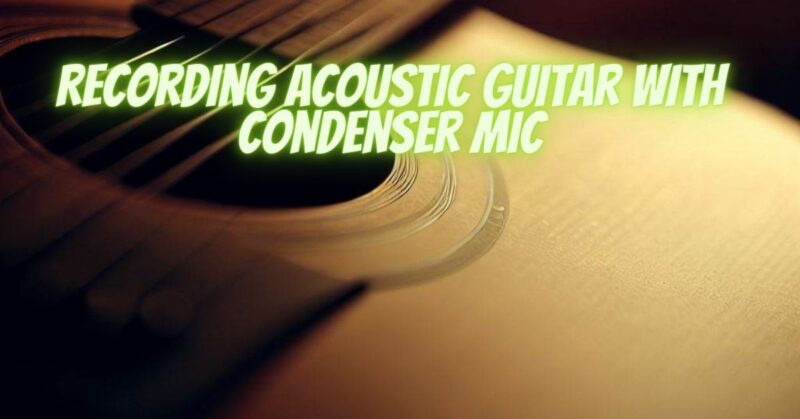Recording acoustic guitar is a rewarding and essential skill for musicians and producers alike. To preserve the authentic and rich tones of an acoustic instrument, using a high-quality condenser microphone is often the preferred choice. In this article, we’ll delve into the art of recording acoustic guitar with a condenser mic, exploring the techniques, microphone placement, and tips to capture the subtle beauty of acoustic sound in your recordings.
Why Choose a Condenser Mic for Acoustic Guitar?
Condenser microphones are known for their sensitivity and ability to capture detailed, natural sound. They are particularly well-suited for recording acoustic instruments due to their wide frequency response and transient response, which accurately capture the nuances and dynamics of the guitar’s tone.
Choosing the Right Condenser Mic:
When selecting a condenser microphone for recording acoustic guitar, consider the following factors:
- Diaphragm Type: Condenser mics come in two diaphragm types: large diaphragm and small diaphragm. Large diaphragm condensers generally provide a warmer and fuller sound, while small diaphragm condensers offer more precise and detailed recordings.
- Polar Pattern: Cardioid is the most common polar pattern used for recording acoustic guitar, as it focuses on capturing sound from the front and rejects background noise and room reflections.
- Frequency Response: Look for a condenser mic with a flat frequency response that accurately captures the guitar’s natural tone without excessive coloration.
Microphone Placement:
The placement of the condenser mic plays a crucial role in capturing the desired acoustic guitar sound. Here are some common techniques:
- Close-Miking: Placing the mic around 3 to 6 inches away from the guitar’s soundhole or fretboard area provides a focused and detailed sound with minimal room ambience.
- Mid-Side Technique: Using two condenser mics—one cardioid (facing the soundhole) and one figure-8 (side-address)—allows you to control the stereo width and balance of the guitar’s sound during post-production.
- X-Y Technique: Positioning two small diaphragm condenser mics in an X-Y configuration above the 12th fret captures a balanced stereo image with excellent mono compatibility.
Room Acoustics and Ambient Sound:
Be mindful of the room acoustics when recording acoustic guitar. If the room has undesirable reflections or excessive reverb, consider using sound-absorbing panels or blankets to improve the recording environment.
Additionally, you can experiment with the amount of ambient sound you want in your recording. Keeping some room ambience can add depth and naturalness to the sound, while using a more intimate and close-miked approach can yield a more focused sound.
Preamp and Signal Chain:
Using a high-quality microphone preamp and audio interface is crucial for obtaining clean and transparent recordings. Ensure that your signal chain is free from noise and interference, as the quality of the preamp and interface can significantly impact the final sound.
Post-Production and EQ:
After recording, use EQ and other processing tools judiciously to enhance the recorded acoustic guitar sound. Pay attention to the guitar’s tonal balance and remove any unwanted frequencies, allowing the subtle nuances and harmonics to shine through.
Recording acoustic guitar with a condenser mic is a journey that requires patience, attention to detail, and a discerning ear. A well-chosen condenser mic, coupled with thoughtful microphone placement and a clean signal chain, can yield captivating recordings that beautifully preserve the essence and subtleties of the acoustic guitar’s sound.
Embrace the art of acoustic recording, and let the versatility and sensitivity of the condenser microphone become your ally in capturing the heart and soul of your acoustic performances. With each recording, you embark on a sonic voyage that immerses listeners in the timeless beauty of acoustic sound, transporting them to a realm of musical authenticity and intimacy.


